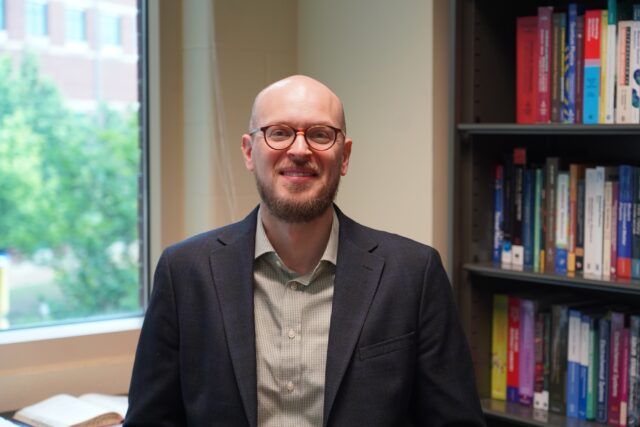By Mackenzie Grizzard | Staff Writer
In the age of iPhones, MacBooks and Teslas, battery-powered devices aren’t just the future — they are our lives. But with great technological power comes scientific responsibility, and one Baylor professor is dedicated to keeping people and their devices as safe as possible.
Dr. Jonathan Larson, assistant professor of chemistry and biochemistry, was invited to share his research at the Volta Foundation Battery Forum, the world’s largest gathering of battery professionals across academia, government and private industries.
“I was thrilled because it seems to not only be a personal encouragement, but hopefully it will be impactful for other people in the field,” Larson said.
At the forum, Larson presented research that he and several others have pioneered over the course of several years. It focuses on interactions that take place on both the chemical and structural level between battery materials and will have major implications for the development of better, safer batteries.
“It’s important for people to know that even though personal electronic devices are all around us and are enabled by batteries, fundamentally the technology that enables them to be handled with care,” Larson said.
The liquid electrolyte in lithium batteries is highly flammable when overheated, which can result in fires and explosions. Larson’s research focuses on developing new technologies to help batteries function safer and more effectively.
“If we can engineer or implement some type of solid state electrolyte, for example, [it] would make batteries significantly safer,” he said.
However, Larson explains that there is a “theoretical limit” that can be reached with certain materials, which is still a developing idea.
“In order to get changes in … energy density, new chemistries are required, such as a silicon anode or lithium metal anode,” Larson said. “Implementing these technologies at scale is still very much in the start-up level.”
Larson’s research meets these ideas with what’s called the interphase, which he describes to his students as a peanut butter and jelly sandwich.
“The anode is one side of a peanut butter and jelly sandwich, and the electrolyte is the other piece of bread, and when you bring the two pieces of bread together, you start doing electrochemistry,” Larson said. “All of a sudden, a thin film of jelly forms between them which is analogous to the interphase.”
The interphase, Larson said, is nano-thin and high reactive, making it difficult to research. Despite this, Larson is hopeful to continue engineering solutions with the combination of several chemistries and disciplines.
“The point of my research is really focused on trying to understand the physical and chemical processes that occur at interfaces in battery materials,” Larson said. “Then we can potentially understand basic mechanisms, then provide that information back to our engineering colleagues to hopefully advance better technologies.”
Larson’s approach focuses on nanoscale resolution in a non-destructive manner and a native environment, which he calls the “three Ns.” The combination of all three is where the research gets difficult, he said.
“This is why infrared nanospectroscopy is really good for this because it’s inherently non-destructive,” Larson said. “So basically, you’re imaging the interface while the battery is still intact.”
With this method, Larson and other researchers are able to characterize the interface structurally and chemically with low-energy infrared light and nanoscale resolution. Studying the battery in its natural environment limits its exposure to high energy x-rays, and has been monumentally successful, Larson said.
“I feel that some of the most interesting problems facing humanity are the ones that reside on blurred boundaries between disciplines,” Larson said. “So I have utilized my personal formal training in applied mathematics to accomplish interdisciplinary research by translating that skill-set into problems important to chemists.”
This research will potentially have incredible real-world applications, according to Dr. John Wood, chair of the department of chemistry and biochemistry at Baylor.
“Jonathan Larson’s presentation to the Volta Foundation’s Battery Forum is a great opportunity to share his research and describe how it could be enabling to future developments in the battery industry,” Wood said in a press release. “He presented the potential capabilities of his laboratory at Baylor, techniques and instrumentation that currently aren’t broadly accessible but can have a real impact.”
As the technology continues to develop under Larson, his research exemplifies Baylor’s commitment to research outlined in its strategic plan, Baylor In Deeds.
“As a Christian, R1 university, we are also on the cutting edge in terms of being able to integrate the latest research in our academic programs, as well as embrace emerging technologies that teach ethical uses of emerging technologies,” Provost Nancy Brickhouse said.
Groundbreaking research aside, Larson remains committed to interdisciplinarity, and recognizes he’s not yet an expert.
“Energy storage is one of the most interdisciplinary topics I can think of, and I think the point is no one is a true expert in energy storage science, because you have to be an expert in all those [disciplines],” Larson said. “Not only is this problem really hard and interesting, but its solution will be potentially impactful.”



